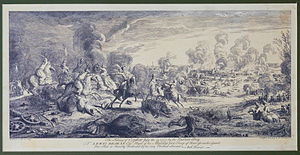Siege_of_Ochakov_(1737)
Siege of Ochakov (1737)
Siege of the Austro-Russian–Turkish War (1735–1739)
The siege of Ochakov (1737) was a siege during the Austro-Russian–Turkish War (1735–39) in which the Russian army, led by Burkhard Christoph von Münnich, captured the Ottoman fortress of Ochakov. It took place in 1737.
